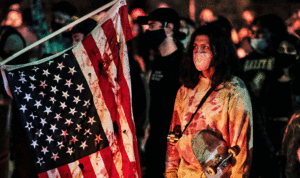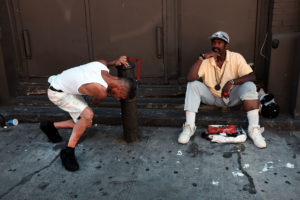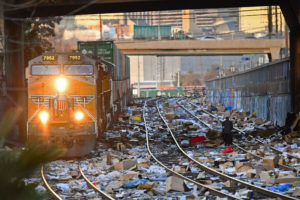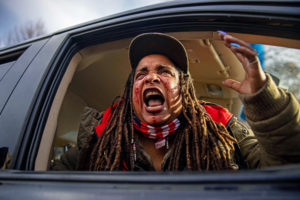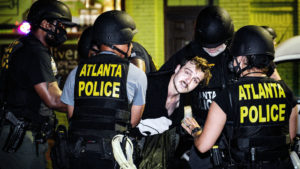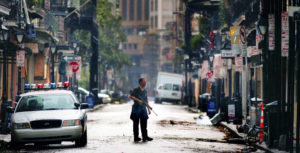This February, Bruce Harrell, newly installed as mayor of Seattle, made it official that his city has gone into decline. “The truth is the status quo is unacceptable,” he said in his first state of the city address. “It seems like every day I hear stories of longtime small businesses closing their doors for good or leaving our city.” But it’s not just small businesses. In mid-March, Amazon announced that it was abandoning a 312,000-square-foot office space in downtown, citing concerns over crime.
That such woes should afflict one of the richest cities in the country, with a median household income of over $100,000, cannot be blamed on economic decline. Yet much of Seattle’s core looks like a pockmarked ghost town. Businesses on both sides of Third Avenue, a major thoroughfare, are boarded up. Blocks from the Four Seasons hotel and the Fairmont Hotel, tents crowd the sidewalks, and drug users sit under awnings holding pieces of foil over lighter flames. Traffic enforcement is minimal to nonexistent. The year 2020 saw a 68% spike in homicides, the highest number in 26 years, and the year 2021 saw a 40% surge in 911 calls for shots fired and a 100% surge in drive-by shootings. Petty crime plagues every neighbourhood of the city, and downtown businesses have paid hundreds of thousands of dollars to fund their own security.
What happened to Seattle? The answer, of course, depends on your politics. In the news section of the Seattle Times, for instance, a reader is unlikely to see any consideration of a link between policing and public safety. “No single cause for 2021’s surge in gunfire in Seattle,” declared a typical recent headline over an article that points only to possibilities such as the pandemic or an unlucky cycle of “retaliatory violence”. But the majority view in Seattle appears to have shifted toward an acknowledgement that the unrest and destruction that occurred after the killing of George Floyd in 2020 marked a turning point and that the city’s policies toward its police force, whose ranks are now depleted, are relevant to understanding the story. What follows, based on interviews with a number of past and present police officers — five of whom are on the record in this article — is an attempt to offer an obvious but unheeded perspective. It is a cop’s-eye view of Seattle’s undoing.
On Monday 25 May 2020, in Minneapolis, a man named George Floyd died after police officer Derek Chauvin pinned Floyd face-down on the pavement with a knee to Floyd’s neck for over eight minutes. Video footage of the incident circulated around the world in the days that followed. One of those to watch it was T.J. San Miguel, a canine handler who had moved from the Big Island of Hawaii to join the Seattle police in 2008. “I thought it was disgusting,” she says of Chauvin’s actions. “You don’t do that to somebody. That’s just basic fucking stuff that we knew and learned and had trained on for years and years. It became pretty apparent that there’s a big difference in training and tactics and procedures in the West Coast versus East Coast and other places.”
The knee to the neck also surprised J.D. Smith, a Marine veteran of the first Gulf War and a Seattle police officer since 1998. Smith had spent years pursuing drug dealers, killers, and pimps and had subdued a lot of people. “That’s not even a proper technique,” says Smith. “We put a knee in between the shoulder blades, and it never chokes anybody out.”
Matthew Kruse, a young patrol officer who had joined the force in 2018, was struck that a handcuffed man would fail to get immediate medical care. “Especially in Seattle, we really emphasise once they’re in handcuffs and they’re under control you turn to the medical attention,” he says. “It’s kind of ingrained, but it’s also just doing the right thing. Do you need something? Do you want to get checked out by medical? If I have water on me, do you want some water?”
But any potential differences between the police in Seattle and those in other places mattered little to the mood of the city in the late spring of 2020. Protests spread from Minneapolis across the country, and the first large-scale demonstrations took shape on Friday night, 29 May, in Seattle’s Chinatown district. Matthew Kruse was among the cops standing guard. “We go down there, and we’re in the riot gear, and people were pleasant,” he says. “For the first three hours, I was just having a conversation with people.” After 10 o’clock, though, the mood shifted. “People were throwing stuff,” Kruse says. “They were starting to shine flashlights in our face.”
On Saturday, the crowds grew destructive. Groups of protesters shattered windows up and down the retail corridors of downtown and emptied many of the stores of their merchandise. Some of those in the crowd torched police cruisers parked outside of the Nordstrom flagship store at Pine Street and 6th Avenue. Protesters also pulled firearms, including M4 rifles, out of the abandoned vehicles. Mike Magan, a robbery detective who had been on the force for over three decades, was home that evening, watching the mayhem on a screen. “I was beside myself,” he says. He recognised the abandoned van of a co-worker, whom he phoned. The colleague, a forensics video specialist, answered in a whisper and said that he and other colleagues were taking shelter in the Nordstrom’s and videotaping what they could of the violence outside.
The following morning, Magan got called into the office to start investigations of 30 to 40 people who’d been arrested for crimes such as trespass, burglary and property destruction. Five or six hours in, he began to suspect they’d given the police false names. But there was no point looking into it further. “We found out they’d all been released from custody prior to even being questioned,” he says.
The bedlam in Seattle caused police leaders to institute a so-called “blue/gold” schedule, meaning that officers had to work 12-hour shifts up to seven days a week. Christopher Young, a detective in the investigative support unit (previously named the criminal intelligence unit), who has been on the force since 1994 and never experienced such a schedule, calls June 2020 “the most stressful month of my life”. Young found himself working 16-hour days for weeks straight. “Even our homicide detectives were sitting at their desks working their cases in battle dress uniforms with their helmets ready to run outside to protect their own office building,” he says, adding that an eight-hour day is already demanding in the world of policing, where split-second decisions are the norm. “There’s been plenty of criticism of how we handled it, but people don’t realise how stressful it was just from the sleep deprivation alone.”
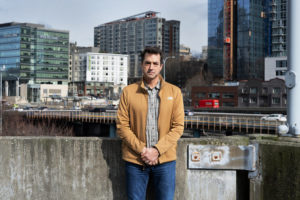
Of the hundreds of businesses that reported being damaged or looted over the weekend, Nordstrom’s flagship store was the most prominent. There had been an attempt by someone to set it aflame. On 1 June, Mike Magan and a colleague from the Seattle bomb unit entered the site to look for possible video footage. The first floor, he says, was destroyed. “All the jewellery cases had been smashed,” he says. “All the cosmetics were gone. All the makeup was gone. Shoes were gone — bags. Everything.” As for tracking down the looters, that wasn’t on the agenda. “We were told: you will not investigate any of those things,” Magan says. “The city attorney wouldn’t file charges on them.”
That night, Magan, who had been out of uniform for decades, had to don riot gear to guard the East Precinct on Capitol Hill. Demonstrations began peacefully but changed after dark. “We were getting pelted with bricks, rocks, frozen water bottles,” says Magan. “There were shots fired. Here I am, 33 or 34 years on the department and I’m like: why am I on the front line here?”
The 12-hour shifts exhausted everyone, including the younger officers. Matthew Kruse was working from 7pm to 7am, mostly on his feet, and if he was out on patrol he had to have riot gear with him in the car in case he was needed for crowd control. Once a week or fortnight, he’d get a day off and spend it all sleeping. “Some nights I slept at the police station,” he says. “And I remember at least a couple of times I just slept in my car, because I was like, if I try to drive home I’m going to kill myself or someone else.”
J.D. Smith, stationed at the West Precinct near the turmoil, was spared a direct confrontation with the violence. His job at the time was to process online crime reports, which were now rolling in faster than ever. But he could see the toll being taken on his coworkers when they returned to the station from the protest sites day after day. “The looks on their faces — it just reminded me of the Gulf War,” he says.
When the protests grew violent, police officers began to use various non-lethal weapons to control the crowd, including pepper spray and tear gas. This led to complaints, lawsuits, and stinging condemnation in the local press. On 5 June, Seattle’s mayor, Jenny Durkan, declared that officers “do not need to be using tear gas at protests as a crowd management tool” and banned the use of it for 30 days. Many officers felt they were being asked to maintain order in violent crowds while surrendering all of their crowd-control tools. “People were throwing bottles and rocks, and we had to split this thing up. God forbid after multiple, multiple, multiple warnings that we’re gonna throw gas, guys, you better disperse, we throw gas,” says J.D. Smith. “So then what? Oh, Seattle PD, look how heavy-handed they are.”
Seattle has never been as police-friendly as some other cities, but outright hostility to law enforcement had until 2020 been confined to a minority of residents. Lots of officers on the force had even been accustomed to positive public attention. T.J. San Miguel and her German Shepherd, Pele — named after the goddess of volcanoes in Hawaii, San Miguel’s native home — had been featured on “America’s Top Dog,” a series putting dogs through obstacle courses, and had cheery write-ups for her work. Mike Magan received regular cards from people he’d helped and, when Covid hit, even a crate of cleaning supplies from one grateful Vietnamese-American family whose jewellery store he had saved when he tracked down four robbers and got all of the stolen goods returned. J.D. Smith became a brief celebrity in 2016, when while off-duty he pulled over on a mountain pass on Interstate 90 to rescue an unconscious woman from a flaming car. All of the cops could point to times when they’d helped save a victim from a bad guy.
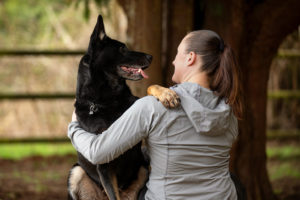
Prior to the summer of 2020 the department had been receiving encouraging communications from the mayor’s office, and city officials were planning to ask the federal government to lift a consent decree that had been imposed on the Seattle police in 2012. In 2016, Barack Obama had even invited the department’s then-chief, Kathleen O’Toole, to the State of the Union, and a federal judge had ruled in 2018 that the city was in “full and effective compliance” with the decree. T.J. San Miguel expected that city officials would take a moment to let the worst of the public anger pass and then speak up for their police force. “I’m like, okay, it was horrible and people absolutely need to say what they need to say,” she says. “So we’re going to give it a minute here in our department, but then our city is going to say: Hey, that was horrible. It was disgusting. It was bad. And guess what? You’ll never see that in the Seattle Police Department.”
That statement did not come. Mayor Jenny Durkan announced on 3 June that the city would no longer seek to lift the consent decree. Seattle city council member Teresa Mosqueda vowed to lead an “inquest” into the budget of the Seattle police and said she wanted to cut funding by half, a view echoed by fellow council members Tammy Morales and Kshama Sawant. City Council president Lorena Gonzáles blamed the police response to the protests for turning “our densest neighbourhoods” into a “complete war zone”.
“In May of 2020, our political leadership considered us a necessary evil,” says Chris Young. “In June of 2020, they started to think that we were an unnecessary evil. Every cultural institution in the city turned on the police.” That included educational institutions. In early June, Young, as a parent of children in Seattle Public Schools, was one of thousands of recipients of an email from school superintendent Denise Juneau announcing that cooperation with the police would be suspended in light of “the perpetuation of systemic racism, the murders of Black people by police officers across our country, [and] the violence displayed by some law enforcement officers here in Seattle”.
The perspective was palpable on the streets, too. T.J. San Miguel would hear jeers out of open windows on Capitol Hill. “You have people in an apartment several stories high just yelling and screaming at you as you’re out there walking down the block,” she says. In one case, a crime victim had called for police help, only to start showering the responding officers with anti-cop abuse when they arrived. “It was very shocking,” she says. “And it’s just like: Okay, bye, have a nice night.”
“We were hated,” says J.D. Smith. “We were literally hated overnight.”
On Sunday 8 June, Matthew Kruse and coworkers from the North Precinct got an order to go down and help back up his colleagues in the East Precinct on Capitol Hill. The plan, he says, was to let crowds march past the precinct unimpeded, unless there was criminal activity, and Kruse and his colleagues were stationed a couple of blocks away, watching the area on camera. No one was trying to break into the precinct, says Kruse, but people started to pitch tents near it. At that point, according to Kruse, a police captain went over to talk to the protesters. “He started talking to protesters and telling them, hey, you guys have got to move along, and they got in a verbal altercation,” says Kruse. “Then they [senior officers] came back to us and said we’re just going to let them stay there and do their thing.” The East Precinct, already boarded up, was now abandoned.
News of the surrender of the East Precinct hit cops hard. “I just felt sick,” says Chris Young. “It was humiliating.” Matthew Kruse found the about-face on holding the fort versus leaving it insulting. “At first they had said: no, we’re not going to let them take the precinct,” says Kruse. “The next day it’s being cleared out.” J.D. Smith remains incredulous. “I’m still embarrassed,” Smith says. “We gave away a precinct.”
What followed for the next few weeks was an impromptu test site for improvised maintenance of public order in what came to be called the Capitol Hill Autonomous Zone, or CHAZ. A few days into the CHAZ, the New York Times described it as “an experiment in life without the police — part street festival, part commune.” Donald Trump weighed in from the Oval Office to condemn it. “Domestic Terrorists have taken over Seattle,” he tweeted. Seattle’s mayor, Jenny Durkan, responded, “It’s not terrorism. It’s patriotism.” Asked by CNN’s Chris Cuomo how long the CHAZ would last, Durkan quipped, “I don’t know. We could have the summer of love.”
For police stationed out of the East Precinct, there was no base of operations anymore. “They couldn’t deploy from there,” says Matthew Kruse. “They had to deploy from the West Precinct or North or South or Southwest or any other precinct. So response times got slower, and that affects everyone from a shop owner to a person who lives there.”
Where some observers saw a harmless street fair others saw something more menacing. “All these businesses are failing and they’re asking for help,” recalls J.D. Smith. “There is nothing, and I mean zero, we can do because the mayor is saying summer of love.” Chris Young says that officers received an email instructing them not to enter the six-block zone of the CHAZ, although he made his way into the off-limits area after some unsuccessful arson attempts against the precinct building. “I was sent with a fancy camera to take pictures of the crime scene of where they tried to burn it down,” says Young. “You had to go by a checkpoint with guards, and God knows what they’d do with me if they found out I was a cop. I had to basically go undercover to sneak in and look at my own precinct.”
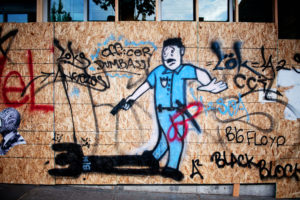
On Saturday 20 June, about 12 days after the East Precinct was vacated, T.J. San Miguel got called in to respond to a shooting of two men in the CHAZ, one of whom was now in a serious condition. “So everybody just goes rolls down there and then, you know, they have to come up with a plan,” she says. “Like, how are we going to get in there?”
By the time a group of officers made it into the CHAZ, they were told the most endangered victim was already being taken to the hospital by activists on the scene. Over the radio in her car outside the CHAZ, San Miguel heard that the victim was being driven in a plain white van toward the Harborview Medical Center, and she happened to look up. “There’s this van driving just crazy,” she says. “The back doors are open and swinging. There’s a bunch of people in the back of the van working, I guess, on this person that was just shot, and I’m just like, oh my god.” San Miguel decided to alert Harborview and escort the van there. “I just jumped ahead of it, lights and sirens,” she says, “and I blocked all the intersections as it went, so it safely got there and no other cars got in the way of it.” In the end, the victim, 19-year-old Horace Lorenzo Anderson, made it to Harborview but didn’t survive.
The CHAZ lasted another ten days after that, until Wednesday 1 July, when officers reclaimed the precinct without a struggle. In the meantime, a 17-year-old had been shot in the arm on 21 June, a 30-year-old male shot and wounded on 23 June, and two black teenagers, 14 and 16, shot and wounded on 29 June as they drove into the CHAZ. The older of the two, Antonio Mays Jr., died of his wounds. Witnesses have stated that members of CHAZ security were the ones who opened fire on them, but police have never tracked down the responsible parties.
Despite the retaking of the East Precinct, the city continued to be racked by protest and strife throughout July, with further vandalism and looting by a subset of the protesters, few of whom ever faced charges. City officials continued to direct their ire toward the police department instead, and on 10 August the Seattle City council voted to cut the pay of senior police staff, including Chief Carmen Best, who enjoyed widespread respect from officers on the force, including all of those interviewed for this article. “It was demoralising,” says Chris Young. “She was a great chief and a very progressive leader who happens to be black. But she still got run out of town on a rail because she wouldn’t agree that her department needed to be abolished.”
Carmen Best immediately announced her resignation. At that time, T.J. San Miguel, who calls Best “excellent, just excellent,” was already deep into looking for an exit. A move like that, when she’d spent years to secure the job of her dreams, working in the K-9 unit, would have been unthinkable in the recent past. She considered herself one of the biggest cheerleaders of the department. But the hostility from the city in June and July changed her outlook. “I realised I could do everything completely right, and if the optics aren’t good, then they’re going to hang me out to dry,” she says. “Once I came to that realisation, it was like a bad breakup where you just shut somebody off.” San Miguel left the force when Best did.
A change in public safety began to be noticeable across the city, not just in protest zones. Seattle’s city attorney, Pete Holmes, and King County’s prosecuting attorney, Dan Satterberg, had always taken a lenient approach to so-called quality-of-life crimes, but after June 2020 they began to ease up across the board toward a range of other offences. Most of those who committed vandalism or looting during the protests escaped any punishment. Matthew Kruse said that storeowners would call the police about shoplifters, not realising that prosecutions of that offence had effectively ceased. On one occasion Kruse and his partner watched a man walk into a store, shoplift about $20 in goods, and walk out. “He was like, what are you guys going to do — arrest me?” says Kruse. “And we knew we weren’t going to arrest him, because with any misdemeanour stuff, we had to go through the prosecutor, and stuff like that wasn’t going to get prosecuted. You could I.D. the suspect and could get a full confession, and they were going be like, ‘We’re not gonna take it.’”
One case in which prosecutors did take action proved to be the last straw for Matthew Kruse’s partner. It involved a shooting that, according to Kruse, everyone involved in investigating believed to be obvious self-defence. A 40-something white Seattle male with no criminal record had shot a homeless Hispanic male who had attacked him in a parking lot at night. The directive from the prosecutors’ office was to jail the man in preparation for pressing murder charges, Kruse recalls, “because of the optics.” Kruse says the case went to trial and ended in swift acquittal, but Kruse’s partner, disgusted by what he viewed as politicised decision-making, quit his job.
With an incentive structure that made officers feel they had little to gain and much to lose from taking the initiative on crime prevention, cops began a dramatic — and some would say resentful — pullback in enforcement. Patrol officers no longer drove or walked about looking for suspicious behaviour like someone climbing a fence but stayed put and responded after the fact. Mike Magan said that one of his colleagues got investigated and punished for responding to a call of shots fired without logging into his computer first. “It was like we were biting our own necks, and you began to see that a lot of these officers would go park their cars at certain location and not go out and patrol,” he says. “You could track the cars and you could see that these officers were parking in parking garages.”
Kruse wanted to keep patrolling, even if it was in a more low-key way, but one day his supervisor advised him to avoid it. “I was told straight to my face: don’t leave the precinct unless you’re going to a call,” Kruse recalls. “He says: I’m looking out for you, still fresh in your career. I don’t want you to get in trouble for doing the right thing.” Kruse says a lot of his coworkers began to rely on an imaginary colleague they dubbed “Officer Time,” so named because most criminal behavior stops on its own after a while. “If it’s a shoplift, the building is going to close, or if it’s someone that’s just trespassing, they’re eventually going to leave,” says Kruse. “So just let them off and let Officer Time handle it.” Kruse quit in October of 2020. The following month, the city council voted to cut the budget of the department by 20%.
For Mike Magan, the pullback in enforcement spread even to his fellow detectives, causing him to hit breaking point. “One of the robbery squads just decided they weren’t going to work anymore,” he says. “They wouldn’t leave the office, they wouldn’t help you on search warrants, they wouldn’t come out and conduct interviews with you. They wouldn’t come out and track video. It was heartbreaking.” Magan couldn’t stand it and decided to retire early. He had banked eight months of sick leave that he intended to exhaust prior to his official departure date, but his ordinary work hours ended after February of 2021.
An exodus of officers led to a manpower shortage that prompted J.D. Smith to quit as well. As someone whose interactions with the public were mostly online at this point in his career, Smith was relatively cushioned from classic hazards of the job. The severe shortage of officers, however, made him certain that he’d be put back into uniform and on street patrol, which he believed spelled trouble for someone out of practice. “It’s tough even when you’re out there every day,” he says. “But you take somebody who has been off the streets for 10 years — they’re rusty.” Returning to the work of chasing down violent criminals in a time of hostile public scrutiny seemed untenable. Smith picked April Fool’s Day of 2021 as his date of retirement. “I had eight more years,” he says. “I needed to stay, financially, but I decided no, I’m going to quit.”
The departing officers left a severely diminished department. Even before the unrest of 2020, the number of officers in the Seattle Police Department was low by the standard of other cities. With about 1,400 police officers in 2019, or 18.5 officers for every 10,000 residents, policing in Seattle could never be as comprehensive as in New York City, where the ratio is 43.6 officers for every 10,000 residents, or Washington, D.C. where it is 54 per 10,000. But with 186 separations from the department in 2020, nearly three times the historical annual average, and another 150 or so in 2021, Seattle started 2022 with well under 1,000 deployable officers department-wide.
Almost all of the officers spoken to for this article seemed to be in low-key mourning over their alienation from the city they served. “I loved going to work every day, and I had a fantastic career,” says Mike Magan. “It’s a beautiful city, but I watched it go from really good to really bad.”
“The mayor and the city council were telling us, basically, that we’re the bad guy,” says J.D. Smith. “The truth is 99% plus of us are amazing people that are only there for the reason that I was there: I don’t like people in fear, and I don’t like people in pain.”
“I’m actually a Left-wing guy on just about every issue,” says Chris Young. “I want the United States to be a Scandinavian-style welfare state. So I’m very sympathetic to people’s concerns.” Forming a complementary department of 100 people comprising community service officers, social workers and others who could do the sort of enforcement that doesn’t require a gun would have been a worthy experiment, Young feels. “But they didn’t do that,” he says. “They just demonised the police and chased good people out of town. It was, let’s slash budgets and hope something good happens.”
Today, T.J. San Miguel works for the police department of Marysville, a town about 30 miles north of Seattle. She had to take a $10-an-hour pay cut, she says, and abandon her work with Pele, starting over as a patrol officer once more. (She did get to keep living with Pele, who is now a full-time pet. “She’s fat and happy,” San Miguel reports.) But the first day of patrol among Marysville residents was a revelation. “People told me face-to-face: We love you. We support you. Thank you for doing your job,” she says. “People were waving. You couldn’t buy your own coffee.”
Matthew Kruse found a job in the police department of Lynnwood, a suburb about 15 miles north of Seattle. Like San Miguel, Kruse was astonished by the contrast between his new workplace and the one he left. In Lynnwood, he says, cops crack down on illegal drug paraphernalia. When someone gets a warrant to show up in court and fails to show, police will arrest the person for ignoring the warrant. When someone shoplifts, that person gets arrested and charged. “I ask people when I catch them shoplifting up here in Lynnwood, ‘What are you doing up here?’” he says.
J.D. Smith moved to Idaho, near Priest River, not far from the Washington border. “It’s affordable, and it got me out of the area,” he says. “I have a chance to start a new life and not be a police officer anymore. I’m hanging the badge up.”
Mike Magan moved to Bozeman, Montana, where he is building a house. In the months that followed his departure from the office, he continued to show up whenever he was needed to wrap up a serious case and make sure the perpetrators were prosecuted. But most of that work has wound down. “I look forward to the transition,” he says. “But I do miss it.”
Remaining on the force is Chris Young, who has seen repeated changes of role as more and more of his colleagues leave. “A few months ago I was just a detective. Now I’m a permanent acting sergeant,” he says. “Half the people in my unit are gone.” Any lull in enforcement that might have existed in the fall of 2020 has long since been replaced by a frantic rush from call to call, as ever fewer officers confront ever higher numbers of crimes.
Part of Young’s job now is to keep more people from leaving, even as the city steps up efforts to repopulate the force. Last October, as vaccine mandates caused even more officers to leave, the mayor put in place an emergency order offering $25,000 bonuses to new hires. But the mindset of the city seems to have mattered just as much to the officers in this story as financial considerations. “My young rockstar detectives are sniffing around these other departments where they’ll get treated like royalty,” Young says. “How do I compete with that?” The answer to that may depend on how much Seattle cares.
Disclaimer
Some of the posts we share are controversial and we do not necessarily agree with them in the whole extend. Sometimes we agree with the content or part of it but we do not agree with the narration or language. Nevertheless we find them somehow interesting, valuable and/or informative or we share them, because we strongly believe in freedom of speech, free press and journalism. We strongly encourage you to have a critical approach to all the content, do your own research and analysis to build your own opinion.
We would be glad to have your feedback.
Source: UnHerd Read the original article here: https://unherd.com

